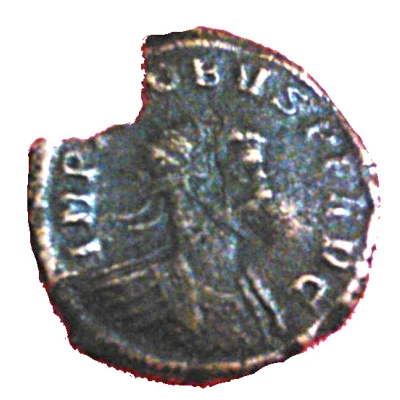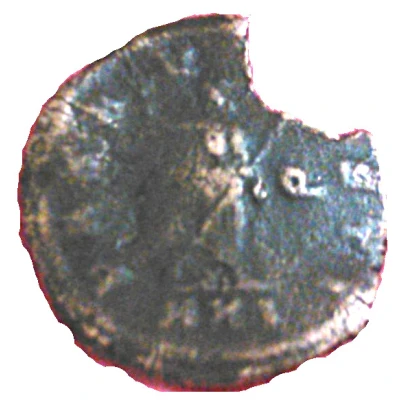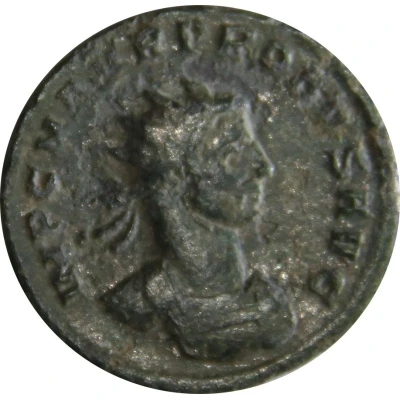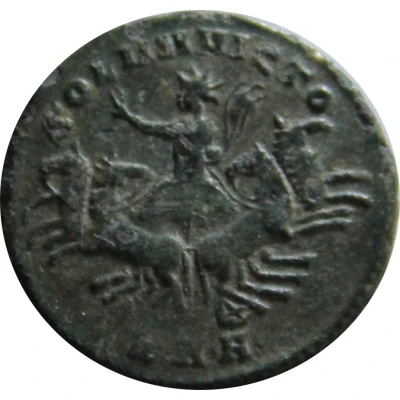
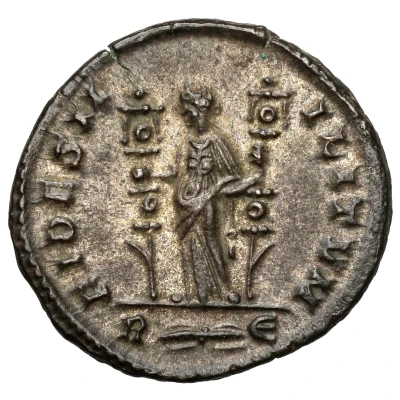

Antoninianus - Probus Cuirassed, right; FIDES MILITVM; Fides
| Silver | - | - |
| Issuer | Rome › Roman Empire (27 BC - 395 AD) |
|---|---|
| Emperor | Probus (Marcus Aurelius Probus) (276-282) |
| Type | Standard circulation coin |
| Years | 280-281 |
| Value | Antoninianus (1) |
| Currency | Antoninianus, Reform of Caracalla (AD 215 – 301) |
| Composition | Silver |
| Shape | Round (irregular) |
| Technique | Hammered |
| Orientation | Variable alignment ↺ |
| Demonetized | Yes |
| Updated | 2024-10-05 |
| Numista | N#64263 |
|---|---|
| Rarity index | 88% |
Reverse
Fides standing left, holding two ensigns
In exergue: Mint mark (R) followed by winged thunderbolt (Ж) or wreath (Ჲ) and officina mark (Є).
Script: Latin
Lettering: FIDES MILITVM
Unabridged legend: Fides Militum.
Translation: Loyalty of the soldiers.
Edge
Plain
Comment
RIC 169 and 170 were minted by the Rome mint, by the 5th officina (the letter ‘Є’). Both have the same reverse, depicting ‘Fides stg. l., holding two ensigns’ and with reverse legend ‘FIDES MILITVM’. There is no other antoninian for the Rome mint with the same reverse in RIC. RIC 169 and 170 only differ in obverse legend and, in part, in exergue mark/emission. The obverse legend of RIC 170 is ‘PROBVS PF AVG’ (Nr. 7 in RIC). See Numista #293962. RIC 169 (and therefore also OCRE) mistakenly lists as obverse legend: ‘PROBVS AVG’ (Nr. 8 in RIC), while in fact it should be ‘IMP PROBVS PF AVG’ (Nr. 4 in RIC). This is corrected by RIC itself on the ’Corrigenda and addenda’-page: “169, for obverse legend 8 read 4” and this correction has been incorporated into Numista.
It is also clear from Pink and Guillemain that there is no antoninian from the Rome mint with the aforementioned reverse depiction/legend with the obverse legend ‘PROBVS AVG’. See: Karl Pink, Der Aufbau der römischen Münzprägung in der Kaiserzeit VI/I, Wien, 1949, p. 42-47 and Jean Guillemain, La Monetazione di Probo a Roma (276-282), Ripostiglio della Venèra-Nuovo Catalogo Illustrato Vol III/1, 2009.
Secondly, RIC 169 mistakenly lists exergue mark R✶Є (the ✶ = ‘star’). As is clear from Pink, R✶Є was used for the 5th officina in the 3rd emission (year 278), while ‘FIDES MILITVM’, with the above mentioned depiction, was only first used in the 5th emission (year 280) of the Rome mint. This is also evident from Guillemain, as well as that the letter ‘E’ from exergue mark ‘RᲲE’ (the Ჲ = ‘wreath’) listed by RIC, is of course an Epsilon (‘Є’) equal to the exergue mark ‘RЖЄ’ (the Ж = ‘winged thunderbolt’) and ‘RIЄ’ (the letter ‘I’) listed for the 5th officina.
There is in fact one true variant obverse legend for the aforementioned reverse depiction/legend not in RIC. Both Pink (p. 45) and Guillemain (#394) list: ‘IMP PROBVS AVG’ (Nr. 6 in RIC). See for an example: probuscoins.fr #4229. Because it is listed as a variant of RIC 169 by Guillemain, it is listed as such in Numista as well. See Numista #293961.
The original RIC text for both RIC 169 and 170 mentions 1 variation/bust type as mentioned below (bust types according to Pierre Bastiens grouping of bust types; see illustrated: probvs.net).
- RIC 169 - IMP PROBVS PF AVG
Exergue mark(s): -/-//RᲲЄ | -/-//RЖЄ
- Radiate, cuirassed, right (B bust, Guillemain #445 (-/-//RᲲЄ), #475 (-/-//RЖЄ)), example: probuscoins.fr #1711, Numista #64263);
- RIC 169var - IMP PROBVS AVG
Exergue mark(s): -/-//RᲲЄ
- [var] Radiate, cuirassed, right (B bust, Guillemain #394 (-/-//RᲲЄ)), example: probuscoins.fr #4229, Numista #293961);
- RIC 170 - PROBVS PF AVG
Exergue mark(s): -/-//RЖЄ | -/-//RIЄ
- Radiate, cuirassed, right (B bust, Guillemain #485 (-/-//RЖЄ), #496 (-/-//RIЄ)), example: probuscoins.fr #245, Numista #293962);
Pink lists exergue mark ‘RЖЄ’ as part of the 5th emission (year 280), ‘RᲲЄ’ as part of the 6th emission (year 281) and ‘RIЄ’ as part of the 7th emission (year 282). Guillemain has a different categorisation of the emissions: Pinks 5th emission in the spring of 281; Pinks 6th emission from summer 281 through early 282 and; Pinks 7th emission in 282. Guillemain is not usually followed in his dating.
RIC 170, with exergue mark ‘RIЄ’, is part of the AEQVITI series of Rome, in which the 5th officina represents the letter I in the exergue. See on these coded series: Gert Boersema, The Translation of the Codewords AEQVITI, IOBI and HPKOY, Forumancientcoins.com, 2007.
Interesting fact
The Antoninianus - Probus coin was part of a series of coins issued during the reign of Emperor Probus (276-282 AD) to celebrate the military victories of the Roman Empire. The coin features the image of Probus himself, cuirassed and holding a spear, symbolizing the military prowess of the Roman army. The inscription "FIDES MILITVM" on the coin translates to "Faith of the Soldiers," highlighting the importance of loyalty and trust within the military. This coin is particularly interesting because it showcases the blending of military and religious themes, which was a common feature of Roman coinage during this period.
